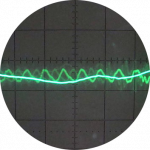Inverter control of power from batteries
In @homonid''s case the wiring can be right first time because it's a renovation project.
But it's also possible to use existing 1½mm² lighting cabling to deliver 24v power to dedicated LED fittings without lifting floorboards!
Obviously, you need to completely remove the relevant wires from the mains MCB in the consumer unit before doing anything else! 😯
Personally I don't like downlighters recessed into a ceiling.
They create shadows and you also end up with a 'dark ceiling'.
A matt white ceiling should be used as a significant asset when considering the illumination of the whole room.
Save energy... recycle electrons!
There was a post here from @homonid about LED lighting which got 'lost' in the ether when posts about Smart Meter issues were relocated here. 😥
Fortunately it's still fresh in my mind, so I can answer both points!
1: I recommended installing 24v DC LED lighting (not 12v).
For the same power output, the wiring will be half as thick when using 24v, which saves needless expense on copper.
To obtain 24v from a storage battery I use DC-DC converters like this:
This steps down from a nominal 48-60v to 24v DC
A typical 20-Amp unit will cost about £30 from Amazon UK, and will probably be enough to supply all lighting in the home.
However, I prefer to buy direct from a reputable seller on AliExpress.
Ask if you need help to buy direct from China.
AliExpress has thousands of 'stores' but you can usually identify the better ones by the number of that product which they've sold.
Their reputation on AliExpress is important to them, whereas anyone can set up a store on Amazon and you don't really know who they are.
I use multiple DC-DC converters and have 24v power outputs around the home.
The assembly in this photo delivers 12v which runs
- broadband router
- WiFi remote Access Point
- external door entry lock
- alarm system
The 19v DC-DC converter supplies a monitor.
It used to do my (older) laptop, but my current one uses a USB Fast-charger input (USB Power Delivery system).
I also use the 'raw' 52v from the storage battery to an Ethernet Switch and a CCTV system, both of which have PoE (Power over Ethernet)
If there's a power outage to the house, then I wouldn't notice it.
2: If you're considering an 'interim' inverter prior to building a whole-house 'off-grid' battery storage at some later date, then I would still suggest that you consider a SunSynk inverter.
I don't (yet) have any here, but I have gained lots of insight into which companies provide inverters that are properly designed.
They key point is that they need to offer features which the householder would actually find useful!
That includes inputs from solar and grid to charge a battery, and the ability to operate in parallel with either single-phase or 3-phase configurations.
At some point, I would hope that the British company, GivEnergy, are also able to deliver a well-designed hybrid inverter.
But they are currently concentrating on the software changes required to get their All-in-One (combined inverter/battery) units operating as they should.
(I think we've also lost a post here from @judith which was a comment on ELV (24v) LED lighting.
But I don't recall it being a question which needed an answer)
Save energy... recycle electrons!
@judith My understanding is that in the commercial luminaires Leds are often overrun (source is Big Clive videos) so they burn out more quickly though I also take @transparents point that the circuit boards are in tiny spaces and overheat and die. Having said that my mains led bulbs are lasting far better now but they are not Gu10. The first low voltage ones I had in my boat years ago were rubbish dying after only a few hours. I am no electronic expert just a hobbyist.
Daikin 6Kw ASHP.
MG4 EV
1926 Semi with loft and wall cavity insulation, all radiator.
@transparent Thanks again for the useful information. So much food for thought. Last nights Panorama made me think it would be best to leave smart meters until the communication problems are resolved. This rather simplifies my plans for battery backup systems as the more sophisticated setups require smart meters to take advantage of smart tariffs.
Posted by: @jancoldMy understanding is that in the commercial luminaires Leds are often overrun
I've discussed the issue with LED chip manufacturers.
They point to the fact that LED wafers have lower temperature tolerances than silicon chips.
Ie LEDs should run 'cold'.
Within LED bulbs the heat comes from the electronics behind the LED emitters.
Due to tight price margins, bulb manufacturers use less-efficient circuitry to -
- convert from AC mains to low-voltage DC
- deliver a constant current through the emitters (LEDs don't use constant voltage)
Too often, the bulb manufacturers use the same aluminium body to act as a heat-sink for both the emitter elements and the electronics.
You can buy some LED bulbs that use higher efficiency electronics, such as these GU10 LEDlite ones from TLC.
But to evaluate the efficiency the customer needs to compare the input watts against the output brightness in lumens.
Anything greater than 100-lumens per watt is worth considering.
Remember also that white-light LEDs use a phosphor to create the wide spectrum.
That deteriorates over time, for which manufacturers' specifications have a L-code.
A white light source marked L70 means that the luminous intensity drops to 70% of the specified value within however many years they state (typically 5 years).
Any manufacturer quoting an L90 specification is therefore telling you that there is a lower decrease in illumination over time for his product.
Typically these bulbs will be using emitters made by the likes of Cree or Epistar, who are the world leaders in this phosphor technology.
Save energy... recycle electrons!
- 26 Forums
- 2,342 Topics
- 53 K Posts
- 480 Online
- 6,000 Members
Join Us!
Worth Watching
Latest Posts
-
RE: Has Anyone Else Noticed a Decline in Tradesmanship?
I don't really know how to respond. My view is that it...
By JamesPa , 40 minutes ago
-
RE: Different dT on each radiator?
The way heating systems are designed will result in rou...
By JamesPa , 2 hours ago
-
RE: Heat Pump Performance Analysis Web App using Modbus Data
I have created a beginners guide to provide a walkthrou...
By redzer_irl , 6 hours ago
-

RE: Setback savings - fact or fiction?
PS by visually merging the two tables as above, I ended...
By cathodeRay , 11 hours ago
-
RE: Samsung ASHP scheduling help
Correction to the post above (my time to edit has run o...
By redzer_irl , 12 hours ago
-

RE: Homely for Daikin Altherma 3 - Petersfield Area
@russ If you would care to pose your questions on one o...
By Toodles , 14 hours ago
-

RE: A Smarter Smart Controller from Homely?
@papahuhu I have a feeling that my Homely smart control...
By Toodles , 14 hours ago
-

RE: The good, the bad and the not that great – my heat pump installation
@cathoderay the guy I spoke to on the phone seemed very...
By Burtis , 23 hours ago
-
RE: Configuration issues with 10kW Midea R32 heat pump
Sorry that was a screenshot of @curlyKatie - mine has...
By SteveT , 1 day ago
-
RE: British Gas vs Octopus Energy vs Heat Geek vs EDF vs Aira vs OVO vs EON.Next vs Boxt
I get the impression that that comment "they don't comm...
By JamesPa , 1 day ago
-

@majordennisbloodnok Just in case there are variations ...
By Toodles , 1 day ago
-

RE: Latest NIBE model has known defect and no solution
@kings I’m glad I could help. NIBE are taking this very...
By Mars , 1 day ago
-
RE: Octopus Cosy Heat Pump Owners & Discussion Thread
@jamespa yes, I'm under no illusions but in some respec...
By AndrewJ , 1 day ago
-
RE: Poll for Time of Use, tariffs, technology
@majordennisbloodnok thanks. Unfortunately i can't upd...
By Tim441 , 2 days ago
-
RE: Electricity price predictions
It seems the end of cfd payments is in sight, even if a...
By Batpred , 2 days ago
-
-
@pie_eater Yes, I installed Homely to a Daikin heat pum...
By gery , 2 days ago
-
RE: Havenwise App Help & Forum Support – Get the Most from Your Heat Pump
@davidalgarve Potentially stupid question, but are you ...
By Sheriff Fatman , 2 days ago
-
RE: What a Bad Heat Pump Installation Looks Like
Spot on, for relatively little money, an air of ready "...
By Batpred , 2 days ago






